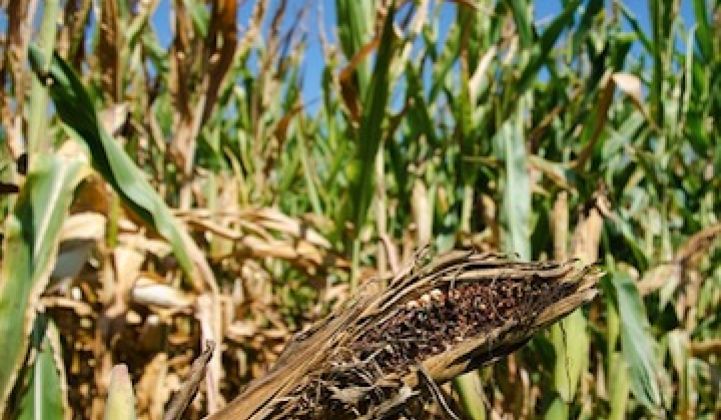It’s become less profitable to make ethanol from corn during this summer of drought in the United States, and less of it is being made.
The U.S. Energy Information Agency reported last week that high corn prices have driven down the profitability of producing ethanol from corn, stating that “ethanol producers may already be cutting back production, as July was the lowest month for ethanol production in the last two years.”
A U.S. renewable fuel standard (RFS) requires blenders to work 13.2 billion gallons of ethanol into gasoline this year. In a normal year, that would eat up about 40 percent of the corn crop. Due to drought, however, this year’s crop has been forecast to come in around 25 percent smaller than normal, so theoretically ethanol would siphon off a greater proportion.
That has spurred a debate about the RFS. The head of the United Nations Food and Agriculture Organization said in early August that waiving the RFS would help ease global food pressures. But it would be misleading to cast this as strictly a food vs. fuel debate. 'Money vs. money' might be equally accurate. On one side are agribusinesses that make ethanol -- they want to keep the RFS in place -- and on the other side are cattle and pork growers, who’d love to see it go away.
The Obama administration -- most notably Agriculture Secretary Tom Vilsack -- has stood firmly behind the RFS, agreeing with the ethanol industry that the program has the flexibility to allow the market to balance out supply and demand pulls and pushes. “The market is already adjusting to lower crop production,” Vilsack said last month in Nebraska. “We should let the market work.”
Defenders of the mandate have pointed to an Iowa State study [PDF] produced in July that found that a reduction in the mandate this year -- or even waiving it entirely -- would have a modest effect on corn prices. The main reason cited was that the RFS already allows obligated parties to carry over blending credits from previous years, which “significantly lowers the economic impacts of a short crop.”
Ethanol interests also dispute the claim that they use 40 percent or more of the corn crop. The industry group Growth Energy says that because just one-third of the kernel is used for ethanol and the protein, fiber and oil are returned to the food chain in the form of high-protein animal feed. So in the end, they claim, just 16 percent of the corn acres harvested goes to ethanol production.
Still, the Environmental Protection Agency, in response to requests for waivers by some governors, has opened a comment period [PDF], through Sept. 26, on the RFS. Meanwhile, even with the RFS still in place, the ethanol industry has been feeling some pain. With little leverage to raise prices for ethanol, the high price of corn has put a squeeze on ethanol plants.
This squeeze can be seen in the 'corn spread,' which measures corn’s impact on the price of ethanol. It’s the per-bushel price of corn divided by 2.8 (the average number of gallons of ethanol produced from a bushel of corn) subtracted from the per-gallon price of ethanol. The corn spread dropped 22 cents since early June, the EIA said. “A negative spread does not necessarily mean that producers are losing money by making ethanol, since the leftover feedstock and other byproducts can be sold,” the agency reported. “However, the $0.22 per gallon drop in the spread since early June has reduced profitability.”
The Renewable Fuels Association, another industry group, told NPR that 10 percent of the nation’s ethanol plants are offline, with the remainder running at 75 percent to 80 percent of capacity.
Meanwhile, one thing folks around the country might wonder is if this summer’s high corn prices have helped drive up gasoline prices. No, the EIA said. “Ethanol is a component of gasoline after blending; however, there is little evidence of the rising corn prices affecting the current price of gasoline,” the EIA reported. “The ratio of the price of gasoline to the price of petroleum (called a 'crack spread') has remained relatively constant, indicating that the rise in cost of gasoline was largely due to the rise in cost of crude oil, and not because of issues specifically related to the gasoline or ethanol markets.”
***
Editor's note: This article is reposted in its original form from EarthTechling. Author credit goes to Pete Danko.



